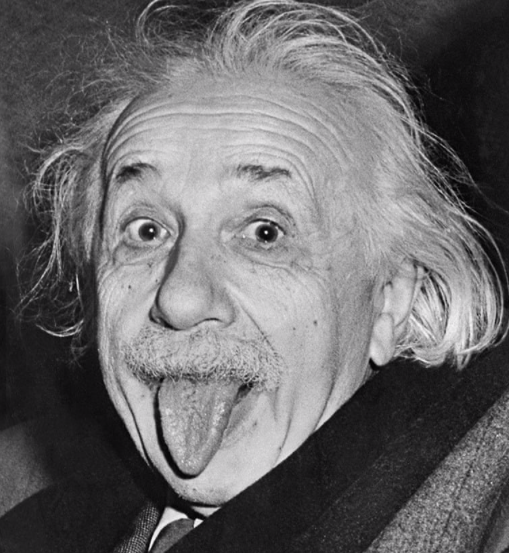Liberating Your Neck and Jaw - 5 - Untying Your Tongue
Albert Einstein photograph: Arthur Sasse: AFP. guardian.com.png
Liberating Your Neck and Jaw - 5 - Untying Your Tongue
Tongue “Posture” is a Thing, and a Bigger Thing Than You Might Have Guessed. - Is it a sign of genius?
This lesson includes touching the lips and tongue with fingers - you may wish to wash your hands before class
In the “Seeing Clearly” series, the tongue was our exquisite sensor for finding where the eyes rest on the palate. For details on the anatomy, physiology and unique features of the tongue, check out my “Seeing Clearly - 6 - Seeing Deeply” blog post. Just know that the tip of the tongue is the part of the body most sensitive to touch, able to move in six directions and make up to 90 words a minute.
In “Orchestra and Balcony - 5 - It’s a Wrap” we looked at keeping the tongue as soft and neutral as possible, and seeking the connection of tongue to pelvic floor via the abs. Here the tongue’s sensitivity was our guide to relaxing facial muscles, especially the circular muscles of the lips.
“Liberating Your Neck and Jaw - 5 - Untying Your Tongue” the evolutionary connections of head, jaw and digestive track ground the lesson. Way, way back, the first living animals were basically mouths that opened to ingest food, closed to process and digest. In our human complexity, it still boils down to that: see food, move to food, ingest food, masticate and swallow.
But there is much more to this lesson than I first realized. Read on …
Your swallow, smile and sleep are more related than you think, Michelle Veneziano, D.O.
“A well-trained tongue pushes on the roof of the mouth with about a pound of pressure each time we swallow, 1,000 to 2,000 times a day. This ongoing action of correct swallowing, coupled with chewing, creates the space needed for a myriad of functions,” says Michelle Veneziano, D.O. “Habitual breathing through the mouth due to allergies is perhaps the most common culprit in keeping the tongue from the roof of the mouth, but we can unknowingly create problems through thumb-sucking, pacifiers, most sippy cups, and even common orthodontic devices.”
She goes on to list the issues related to a dropped tongue:
Sinuses and ears drain poorly
The powerful inward forces of muscles of the cheeks can, over time, create a long, narrow face and palate and a crowded bite.
Crowded airways that lead to snoring
The head, neck and jaw jut forward and drop down to allow air to pass more easily, wreaking havoc on the jaw and neck muscles and jaw, neck and back pain that won’t easily resolve.
Sticking out your tongue may improve your game. Lee Westwood demonstrates the technique. Source: www.better-golf-by-putting-better.com
The tongue also influences athletic performance. The acute effect of the tongue position in the mouth on knee isokinetic test performance: a highly surprising pilot study, Muscles Ligaments Tendons J. 2013 Oct-Dec; 3(4): 318–323: “ From practical field experience with some athletes describing their own way to manage powerful exercise output, it results that the power output of a joint movement could be influenced by the tongue position in the mouth while performing such strong tasks. The usual position of the tongue is described as lying on the lower arch of the mouth or extended up to the palatine spot depending on author… The present study showed a significant improvement in the isokinetic knee performance with the tongue in the UP position compared to the tests with the MID and LOW positions.” In other words, tongue position can improve your kick or swing.
The mechanics of this lesson will be familiar to regular students, but our focus shifts to the tongue as the furthest tip of the spine, and how it affects the balance of the head and jaw. This is a supine - lie on your back - lesson. It begins with fingertips probing and exploring the movements of the lips. Then the super-sensitive tongue takes over to stretch and relax the facial muscles. The lesson ends connecting the tongue to the knees - the better to kick you with my dear! Or the better to make music, imagine the movement of stars, sleep perchance to dream…
Lots of science nerd candy this week. Some of the recommended videos relate to last week’s exploration of the cervical spine. And some fun and weird videos on the facial muscles and tongue.
Your swallow, smile and sleep are more related than you think (web page on nasal breathing, with other good info)
MUSCLES OF FACIAL EXPRESSION AND MASTICATION SONG – funny run through the anatomy of the face – play fast for full silliness (4:40)
Neck Stretches for Instant Pain Relief - shows how the different muscles of the neck and spine work in different orientations – Muscles in Motion (1:26)
Trapezius Workout – shows the relationships between neck, upper back and rest of body muscles – Muscles in Motion (1:30)
How your tongue affects your strength & vision - your brain prefers your tongue in a specific place, and will thank you with performance increases. ZHealthPerformance (4:48)
How You Might Feel After This Lesson: Amazed at the tongue; Tongue connections to cheeks, neck, shoulders and … knees; Deeply relaxed; Soft Face (I’m ready for my close up, Mr. DeMille); Tall, elegantly postured; Better athletic performance (?) - let me know; Playful like a genius.





